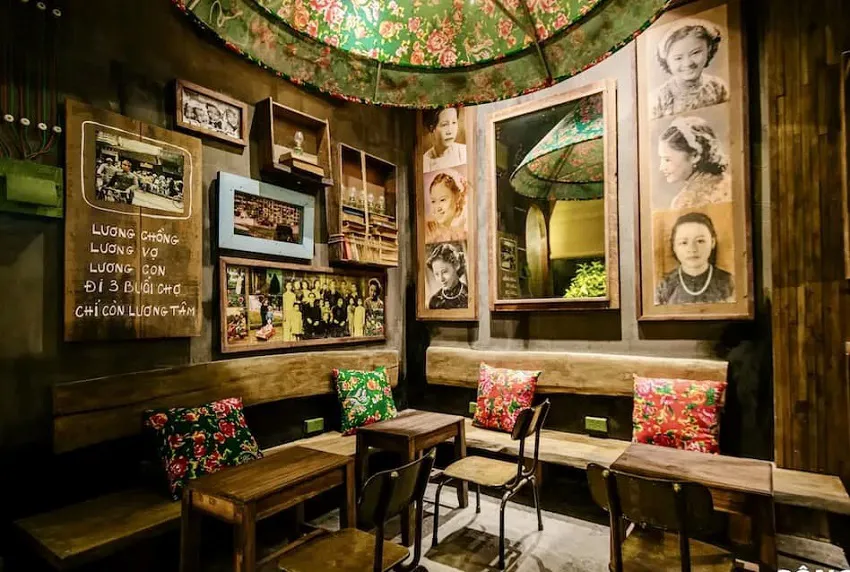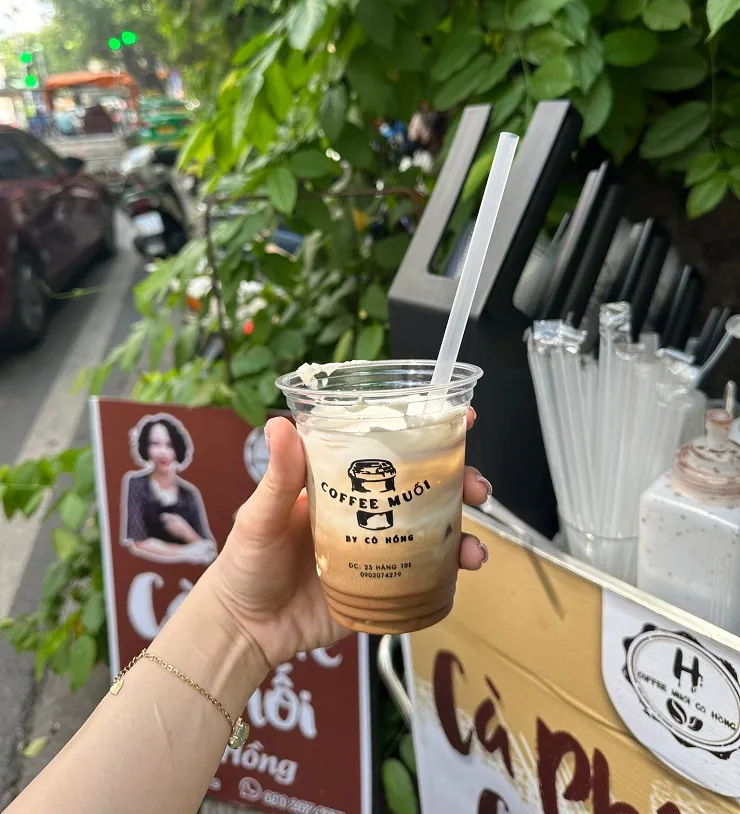In Hanoi, don’t rush to get caffeinated
Amid the hustle and bustle of the capital, one could find a strange sense of tranquility by sitting near a window in the early morning sunlight, breathing in the slightly cool air, and sipping a cup of hot coffee.
Hanoi is unique in the sense that you can find many things to do and eat just by strolling down the sidewalk. Many street dishes here have become the capital’s specialties. Ca phe, Vietnamese for “coffee” is one of them.
Old-fashioned but mesmerizing
| Having a cup of coffee on a sidewalk cafeteria is a hobby of many Hanoians. Photo: Railway Cafe |
In the late 19th century, the French introduced coffee to Vietnam and planted it in several provinces and cities. All the output was brought to Hanoi, partly to serve the French expats and partly to be sent to their homeland.
A luxury drink in France at that time, coffee spread widely in Vietnam thanks to the country’s suitable soils. Hanoians also tried and gradually fell for the aromatic drink with a slightly bitter aftertaste. That’s when coffee drinking became a local habit.
In Hanoi, any tasty food or drink can be found on the sidewalk. Many street dishes have become the capital’s specialties - Ca phe is a typical example.
Hanoians’ style of enjoying coffee is strongly influenced by their love for the familiar sidewalk and watching street life. For them, the views a cafe boasts define its appeal as much as the drinks and service quality.
This explains why most cafes around the city have a half-indoor, half-outdoor style. Roaming areas such as the Old Quarter, Hoan Kiem Lake, West Lake or Thien Quang Lake, tourists usually come across coffee shops with a few small chairs and tables arranged in front.
| These cups of Ca phe trung or egg coffee are ready to be served at Ca Phe Giang, a famous cafeteria in Hanoi's Old Quarter Area. Photo: Dia chi an uong |
Similarly, customers often choose to sit by windows or on terraces - corners closest to the street.
The citizens also like simplicity and quiet spaces that are a bit old. Despite the encroachment of large coffee chains, with modern designs and decorations mainly for young customers’ selfies, true coffee junkies still prefer a street-view corner at Cafe Lam, Cafe Giang or Cafe Huan - spots that have maintained their dated look over the years.
Unique Hanoian coffee
According to the culinary website Taste Atlas, four of the nine most popular Southeast Asian coffees are from Vietnam. They are Ca phe trung or egg coffee, Ca phe da or iced coffee, Ca phe sua or ‘milk’ coffee and Sua chua ca phe or yogurt coffee.
Of all these drinks, Ca phe trung is the most special and increasingly popular for Hanoians.
When hearing about egg coffee, even Vietnamese people in other places, let alone foreigners, find it strange. Surprised, curious, and even hesitant about the taste of egg in coffee, they are quickly enchanted by the strange buttery flavor and fragrance.
| Opened by Nguyen Van Giang in 1946, when he was a bartender for the Sofitel Metropole Hanoi 5-star hotel, Giang Ca phe is also the birthplace of egg coffee in Vietnam. Photo: Giang Dinh |
Ca phe trung is a creation of Cafe Giang - a well-known family with a long tradition of selling coffee in the capital.
Invented by Nguyen Van Giang in 1946, the recipe for ca phe trung has remained virtually unchanged for decades, with the main ingredients being egg yolk, Vietnamese coffee powder, sweetened condensed milk, butter, and cheese.
Enjoying a hot ca phe trung is a hobby of Giang Dinh, a resident of Ho Chi Minh City, whenever she travels to Hanoi. "I am deeply in love with Café Giang's egg coffee, and I don't mind traveling so far for this specialty. The wonderful rich taste of Giang's egg coffee can't be found anywhere else in the world," she told The Hanoi Times.
According to the owner of Café Giang, a delicious cup of egg coffee requires skilled hands and exquisiteness with several preparation steps.
A delicious cup of egg coffee requires skillful hands and exquisiteness. First, egg yolks are beaten with a bit of honey or sugar until they are creamy and have a rich aroma. Then hot, freshly brewed coffee is added until the cream floats to the top. Finally, a little more coffee powder is sprinkled on top to make it stand out," he explained.
When having this drink, diners should carefully use a spoon to scoop up the coffee at the cup bottom to enjoy with the egg cream. And don’t forget to bring the whole cup to one's mouth and inhale it before sipping.
| The funky space of Cong Ca Phe in the West Lake, Hanoi. Photo: Dia chi an uong |
The bitter taste of the coffee mixed with the sweet egg cream, along with the aroma of the cream foam lingers on the lips. It is as if the dormant taste buds are suddenly awakened.
Ca phe trung has always been one of the top street food choices in the capital and a favorite among tourists, especially those from Japan, China and South Korea. The cup of black coffee, topped with a captivating yellow layer of egg cream, has become an icon of Hanoi cuisine.
Besides egg coffee, Ca phe cot dua, or coconut milk coffee, is a creation of the famous Cong Ca Phe in Hanoi, and has been a trendy drink among domestic and foreign tourists for over a decade.
The recipe is simple but also requires meticulousness. Fresh milk, condensed milk and coconut milk are mixed in a certain ratio and whipped until creamy. Next, filtered coffee is put into a shaker, or whisked until bubbles form.
| The space of Ca phe Pho co (Old Street Cafe) in Hanoi's downtown. Photo: Ca phe Pho co |
Lastly, this coffee is poured into the coconut cream to complete a mouth-watering cup of coconut coffee. Usually served with ice, Ca phe cot dua is so aromatic and refreshing that it is gaining more and more devotees as an indispensable item on the menu of Hanoi’s coffee shops.
Recently, Hanoians have become familiar with Ca phe muoi or salted coffee, a new specialty introduced by people from Hue City. Made of coffee, salty cream and a touch of condensed milk, the drink has a strong taste, creating a fever on social networks.
No matter how many variations have appeared, the majority of Hanoi coffee drinkers still stick to Den da or iced black coffee, Nau da or iced brown coffee, Den nong, hot black coffee, and Nau nong, hot brown coffee as “true loves”.
Sometimes, watching the coffee drip into the cup is also a way to live slowly in the city associated with the slogan: “In Hanoi, don’t hurry” And when you walk into a street and order a drip coffee, why not take your time?
| A cup of Ca phe muoi, or salted coffee, is served in Ms.Hong's sidewalk cafeteria in Hanoi's Old Quarter Area |

















